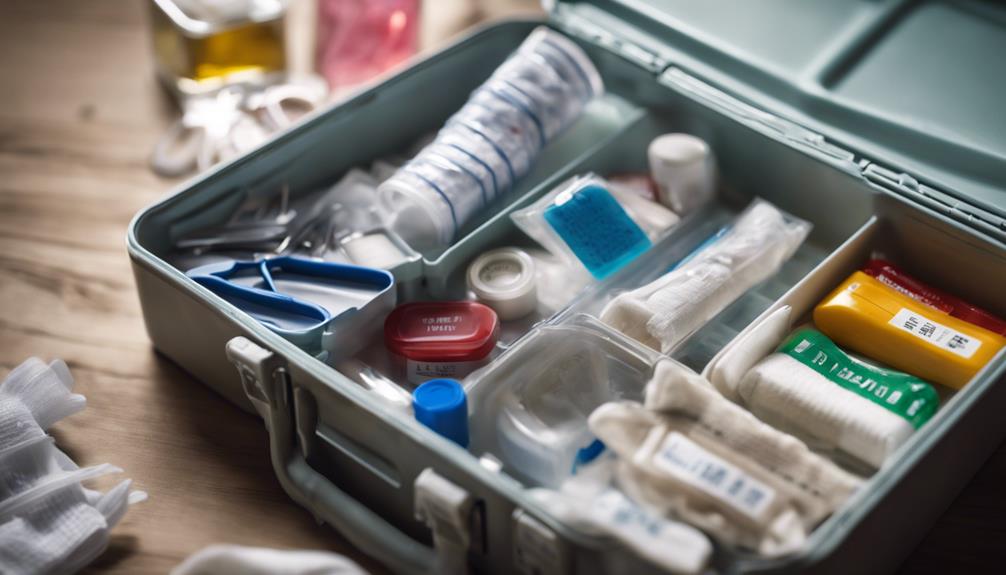Mastering evacuation is essential for preppers to guarantee safety from natural disasters, fires, and other emergencies. Key strategies include forming a thorough evacuation plan, preparing portable shelters, and utilizing multi-purpose vehicles for transport and resource storage. Essential supplies encompass water collection systems, survival food, and medicinal plants. Long-term survival requires stockpiling diverse resources and maintaining adaptability through regular skills training. Effective shelter designs and transportation logistics enhance resilience during crises. Understanding these components can greatly improve survival outcomes in emergencies. For further insights into optimizing your preparedness strategy, explore additional essential techniques and resources.
Key Takeaways
- Develop a comprehensive evacuation plan addressing transportation, shelter, and resource logistics for various emergency scenarios.
- Stockpile essential supplies like food, water, and medicinal plants, ensuring they're easily transportable and accessible.
- Utilize multi-purpose vehicles, equipped for transport and temporary living, to enhance mobility and resource management during evacuations.
- Incorporate portable rain catchment systems and adaptable growing systems to secure water and food sources in the aftermath of an emergency.
Reasons to Evacuate
There are several critical reasons that may necessitate the evacuation of a prepper retreat, including natural disasters, safety threats, and environmental hazards.
Fire hazards can rapidly destroy essential property and resources, while flooding can make areas both inaccessible and unsafe for inhabitants.
Additionally, the emergence of marauding hordes poses significant threats to personal safety and security.
Natural disasters, such as hurricanes and tornadoes, can inflict extensive damage, leading to urgent evacuation needs.
Moreover, water contamination can precipitate health crises, drastically reducing the availability of safe drinking water.
Each of these factors underscores the importance of having a robust evacuation plan that accounts for various emergency scenarios, ensuring the safety and well-being of all individuals involved.
Essential Preps for Evacuations
Developing a thorough evacuation plan requires careful consideration of the necessary preparations to guarantee safety and survival during emergencies.
Key essentials include a portable rain catchment system for efficient water collection, along with a survival seed stash and long-term food storage to sustain your group.
Additionally, livestock evacuation strategies must account for transport logistics, feed supply, and first aid resources.
It is also essential to stockpile medicinal plants and herbs in easily transportable formats.
Finally, utilizing portable shelters such as campers or trailers can provide multi-functional benefits during an evacuation, ensuring that you have both living space and storage for critical supplies.
These strategic preparations will enhance your resilience in uncertain situations.
Importance of Multi-Purpose Vehicles

Utilizing multi-purpose vehicles is essential for effective evacuation, as they provide important transportation, shelter, and storage capabilities during emergencies. These vehicles can navigate diverse terrains, guaranteeing access to remote locations while transporting critical supplies.
All-terrain vehicles (ATVs), for example, can be adapted with cargo racks and trailers, enhancing their capacity for gear and resources. Additionally, equipping vehicles with toolboxes allows for on-the-spot repairs and easy access to emergency equipment.
Training all potential drivers, including younger individuals, to operate these vehicles effectively is imperative for family safety and preparedness. By selecting the right multi-purpose vehicle, preppers can guarantee a streamlined evacuation process, thereby increasing their chances of survival and maintaining their quality of life during crises.
Shelter and Living Arrangements
Effective shelter and living arrangements are crucial for maintaining safety and comfort during emergency evacuations. Preppers must consider various factors to guarantee their living quarters meet immediate needs.
Bugout vehicles often serve dual purposes, providing both transportation and temporary living space. Additionally, planning for adaptable shelter designs can facilitate the establishment of portable growing systems.
Key considerations include:
- Weather Resilience: Confirm shelters can withstand diverse weather conditions.
- Livestock Management: Incorporate temporary fencing and care strategies for livestock during transport.
Long-Term Survival Considerations

Long-term survival hinges on the strategic preservation of resources and the continuous development of essential skills within the prepper community.
Effective preservation techniques, such as drying and fermenting herbs and plants, guarantee access to critical medical supplies. Automating systems for water collection and food production enhances efficiency and reduces labor, allowing for greater adaptability in shifting circumstances.
Regular training sessions in survival skills are imperative for maintaining proficiency among all group members, fostering a knowledgeable and resilient community.
Stockpiling a diverse array of food and water sources mitigates the risk of shortages, while the regular evaluation of evacuation plans keeps preparedness at the forefront.
Ultimately, a proactive approach guarantees long-term viability in any survival scenario.
Frequently Asked Questions
How Do I Choose the Best Evacuation Route?
To choose the best evacuation route, assess current conditions, prioritize safety and accessibility, consider potential hazards, utilize reliable navigation tools, and maintain flexibility to adapt to unforeseen circumstances during the evacuation process.
What Should I Do With Pets During Evacuation?
In times of crisis, prioritize your pets' safety. Guarantee their transport needs are met with crates, ample food, and water. Familiarize them with the vehicle to reduce anxiety and maintain comfort during evacuation.
How Can I Stay Informed During an Emergency?
Staying informed during an emergency requires utilizing multiple sources, including emergency alert systems, local news, social media, and radio broadcasts, while ensuring access to reliable communication devices to receive timely updates and critical information.
What Communication Methods Should I Use While Evacuating?
During emergencies, nearly 70% of individuals rely on smartphones for communication. While evacuating, utilize text messaging, satellite phones, and two-way radios to guarantee reliable communication, especially when traditional networks may be compromised or unavailable.
How Can I Ensure My Privacy and Security During Evacuation?
To guarantee privacy and security during evacuation, utilize discreet travel routes, maintain low profiles, employ secure communication methods, safeguard personal information, and establish clear protocols for accessing supplies while minimizing exposure to potential threats.
Conclusion
Ultimately, mastering evacuation strategies is paramount in an era fraught with uncertainties. The ability to swiftly navigate threats such as natural disasters and societal unrest can mean the difference between safety and chaos. Once a well-rehearsed evacuation plan is in place, it’s also crucial to focus on protecting your retreat. This can involve fortifying your property, securing essential supplies, and staying informed about potential threats. By taking proactive measures, individuals and communities can better ensure their safety and security during times of hardship.
By implementing essential preparations, leveraging multi-purpose vehicles, and considering long-term survival, individuals and communities can foster resilience.
Ultimately, being well-prepared transforms the intimidating prospect of evacuation into a manageable endeavor, ensuring that readiness becomes second nature in the face of life's unpredictability—a veritable superpower.










